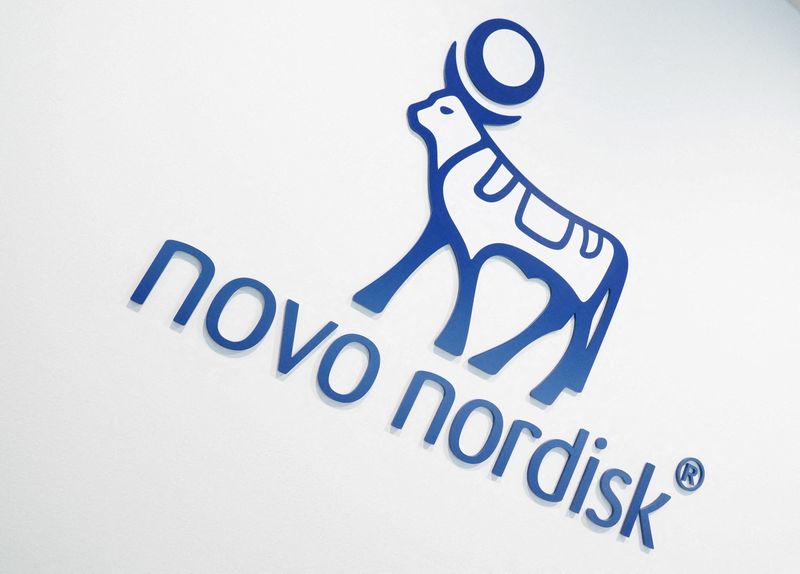By Jacob Gronholt-Pedersen and Maggie Fick
COPENHAGEN/LONDON (Reuters) -Novo Nordisk on Wednesday forecast another year of double-digit growth as the Danish drugmaker began boosting U.S. supplies of its popular weight-loss drug Wegovy and pledged to roll out in new markets amid competition from Eli Lilly (NYSE:LLY).
The company, which has raced to increase output of the blockbuster drug amid shortages, said it was more than doubling supply of lower strength or "starter" Wegovy doses in the U.S. in January compared with recent months.
Boosting supplies is the first sign of progress in Novo's efforts last year to increase output, helping soothe investor concerns it may lose out to rivals like Lilly, which recently launched its Zepbound therapy in the U.S. and Europe.
Novo has been unable to meet runaway demand for Wegovy, and in May began limiting the number of U.S. patients who can start treatment by reducing the supply of the lowest three doses of the appetite-suppressing weekly injection.
"For the foreseeable future, I don't think we can saturate the whole demand," he told Reuters. As long as that's the case, the company will likely need to control access for new patients to ensure they have continuous supply of medication, he said.
The company said it expects prices of Wegovy to fall as volumes of the weekly injection increase and competition heats up with Lilly launching Zepbound in new markets.
"We also expect that as volumes continue to expand, prices will gradually come down. But that will be much more than offset by the volume expansion," Chief Financial Officer Karsten Munk Knudsen said on a media call.
The company's shares, which traded as much as 3.9% higher at opening at fresh record highs, were up 0.2% at 1023 GMT.
Novo investor Yuri Khodjamirian, chief investment officer at ETF issuer Tema, said guidance was "decent" and welcomed news about improved Wegovy supplies.
"This should be a big driver in a year where they face competition for the first time in the obesity market," he said.
SHORTAGES PERSIST
Novo has spent billions of dollars ramping up output of Wegovy over the past year, deploying in-house capacity and hiring outside contract manufacturers.
Jorgensen confirmed to Reuters for the first time that Catalent (NYSE:CTLT)'s Indiana plant in the U.S. has started filling injection pens. The site is the third external production site doing so-called "fill-finish" for the weight-loss drug.
"The plan of ramping up capacity is moving forward as we have planned," he said.
Novo has not officially lifted the restriction placed on starter doses in May. Four out of five dose strengths of Wegovy remain in shortage in the U.S., according to the U.S. Food and Drug Administration website.
Wegovy sales totalled 9.6 billion Danish crowns ($1.39 billion) between October and December, slightly lower than the previous quarter and a four-fold rise from a year earlier.
The company said it aimed this year at "a gradual roll-out of Wegovy with capped volumes" outside the U.S.
Novo expects sales growth this year between 17% and 25% and operating profit to rise 19%-27% as demand soars for Wegovy and diabetes drug Ozempic, which contains the same active ingredient.
Analysts on average expect Novo Nordisk (NYSE:NVO) to deliver sales growth of 21% this year, according to LSEG data.
While the pace is slower than last year's phenomenal growth, the outlook reflects growing competition, pricing pressure and growth in both North American and international markets.
Novo has launched Wegovy in eight countries, including Germany and Britain, since its debut in the U.S. in 2021.
The company said fourth-quarter sales rose 37% from a year earlier to 65.9 billion crowns, compared with 62.3 billion forecast by analysts in an LSEG poll.
Earnings before interest and taxation (EBIT) rose 57% to 26.8 billion, versus a forecast of 24.9 billion.
The results underscore Wegovy's success and Novo's lead in the fast-growing obesity drug market.

Strong demand for Wegovy and Ozempic has propelled Novo's shares to record highs, making it Europe's most valuable listed company, worth more than 450 billion euros ($487 billion), ahead of LVMH.
It also provided an economic bonanza for its home country of Denmark.
